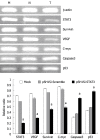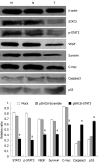Silencing of signal transducer and activator of transcription 3 expression by RNA interference suppresses growth of human hepatocellular carcinoma in tumor-bearing nude mice
- PMID: 19496189
- PMCID: PMC2691490
- DOI: 10.3748/wjg.15.2602
Silencing of signal transducer and activator of transcription 3 expression by RNA interference suppresses growth of human hepatocellular carcinoma in tumor-bearing nude mice
Abstract
Aim: To explore the effect of silencing of signal transducer and activator of transcription 3 (STAT3) expression by RNA interference (RNAi) on growth of human hepatocellular carcinoma (HCC) in tumor-bearing nude mice in vivo.
Methods: To construct the recombinant plasmid of pSilencer 3.0-H1-STAT3-siRNA-GFP (pSH1-siRNA-STAT3) and establish the tumor-bearing nude mouse model of the HCC cell line SMMC7721, we used intratumoral injection together with electroblotting to transfect the recombinant plasmid pSH1-siRNA-STAT3 into the transplanted tumor. The weight of the nude mice and tumor volumes were recorded. STAT3 gene transcription was detected by semi-quantitative reverse transcription polymerase chain reaction (RT-PCR). Level of protein expression and location of STAT3 were determined by Western blotting and immunohistochemical staining. STAT3-related genes such as survivin, c-myc, VEGF, p53 and caspase3 mRNA and protein expression were detected in tumor tissues at the same time. The terminal deoxynucleotidyl transferase-mediated dUTP nick end labeling (TUNEL) assay was used to detect apoptosis of tumor cells.
Results: The weight of the treated nude mice increased, and the tumor volume decreased markedly compared with those of the mock-treated and negative control groups (P < 0.01). The results of RT-PCR and Western blotting showed that mRNA and protein levels of STAT3 declined markedly in the treated group. The change in STAT3-related gene expression in tumor tissues at the mRNA and protein level also varied, the expression of survivin, VEGF and c-myc were obviously reduced, and expression of p53 and caspase3 increased (P < 0.01). Most of the tumor tissue cells in the treated group developed apoptosis that was detected by TUNEL assay.
Conclusion: Silencing of STAT3 expression by RNAi significantly inhibits expression of STAT3 mRNA and protein, and suppresses growth of human HCC in tumor-bearing nude mice. The mechanism may be related to down-regulation of survivin, VEGF and c-myc and up-regulation of p53 and caspase3 expression. Accordingly, the STAT3 gene may act as an important and effective target in gene therapy of HCC.
Figures








Similar articles
-
Knockdown of Stat3 expression using RNAi inhibits growth of laryngeal tumors in vivo.Acta Pharmacol Sin. 2006 Mar;27(3):347-52. doi: 10.1111/j.1745-7254.2006.00277.x. Acta Pharmacol Sin. 2006. PMID: 16490172
-
[Effect of silencing VEGF, c-myc, survivin and hTERT by multiple shRNA expression vectors on the xenografted human nasopharyngeal carcinoma in nude mice].Zhonghua Er Bi Yan Hou Tou Jing Wai Ke Za Zhi. 2010 Nov;45(11):935-40. Zhonghua Er Bi Yan Hou Tou Jing Wai Ke Za Zhi. 2010. PMID: 21215210 Chinese.
-
Characterization of STAT3 activation and expression in canine and human osteosarcoma.BMC Cancer. 2009 Mar 10;9:81. doi: 10.1186/1471-2407-9-81. BMC Cancer. 2009. PMID: 19284568 Free PMC article.
-
Natural bioactive compounds and STAT3 against hepatocellular carcinoma: An update.Life Sci. 2024 Jan 15;337:122351. doi: 10.1016/j.lfs.2023.122351. Epub 2023 Dec 15. Life Sci. 2024. PMID: 38103726 Review.
-
Survivin as a global target of intrinsic tumor suppression networks.Cell Cycle. 2009 Sep 1;8(17):2708-10. doi: 10.4161/cc.8.17.9457. Epub 2009 Sep 7. Cell Cycle. 2009. PMID: 19717980 Free PMC article. Review.
Cited by
-
The combination of immunotherapy and a glutamine metabolism inhibitor represents an effective therapeutic strategy for advanced and metastatic murine pancreatic adenocarcinoma.Int Immunopharmacol. 2023 May;118:110150. doi: 10.1016/j.intimp.2023.110150. Epub 2023 Apr 6. Int Immunopharmacol. 2023. PMID: 37030115 Free PMC article.
-
Immunotherapy and Gene Therapy for Oncoviruses Infections: A Review.Viruses. 2021 May 2;13(5):822. doi: 10.3390/v13050822. Viruses. 2021. PMID: 34063186 Free PMC article. Review.
-
STAT3 knockdown reduces pancreatic cancer cell invasiveness and matrix metalloproteinase-7 expression in nude mice.PLoS One. 2011;6(10):e25941. doi: 10.1371/journal.pone.0025941. Epub 2011 Oct 3. PLoS One. 2011. PMID: 21991388 Free PMC article.
-
Downregulation of STAT3 signaling induces apoptosis but also promotes anti-apoptotic gene expression in human pancreatic cancer cell lines.Tumour Biol. 2011 Jun;32(3):493-500. doi: 10.1007/s13277-010-0143-4. Epub 2010 Dec 21. Tumour Biol. 2011. PMID: 21174186
-
Mannan-BAM, TLR ligands, and anti-CD40 immunotherapy in established murine pancreatic adenocarcinoma: understanding therapeutic potentials and limitations.Cancer Immunol Immunother. 2021 Nov;70(11):3303-3312. doi: 10.1007/s00262-021-02920-9. Epub 2021 Apr 15. Cancer Immunol Immunother. 2021. PMID: 33855601 Free PMC article.
References
-
- Gartel AL, Kandel ES. RNA interference in cancer. Biomol Eng. 2006;23:17–34. - PubMed
-
- Wu X, Fan J, Wang X, Zhou J, Qiu S, Yu Y, Liu Y, Tang Z. Downregulation of CCR1 inhibits human hepatocellular carcinoma cell invasion. Biochem Biophys Res Commun. 2007;355:866–871. - PubMed
-
- Salvi A, Arici B, Portolani N, Giulini SM, De Petro G, Barlati S. In vitro c-met inhibition by antisense RNA and plasmid-based RNAi down-modulates migration and invasion of hepatocellular carcinoma cells. Int J Oncol. 2007;31:451–460. - PubMed
-
- Bromberg JF, Wrzeszczynska MH, Devgan G, Zhao Y, Pestell RG, Albanese C, Darnell JE Jr. Stat3 as an oncogene. Cell. 1999;98:295–303. - PubMed
Publication types
MeSH terms
Substances
LinkOut - more resources
Full Text Sources
Medical
Research Materials
Miscellaneous

